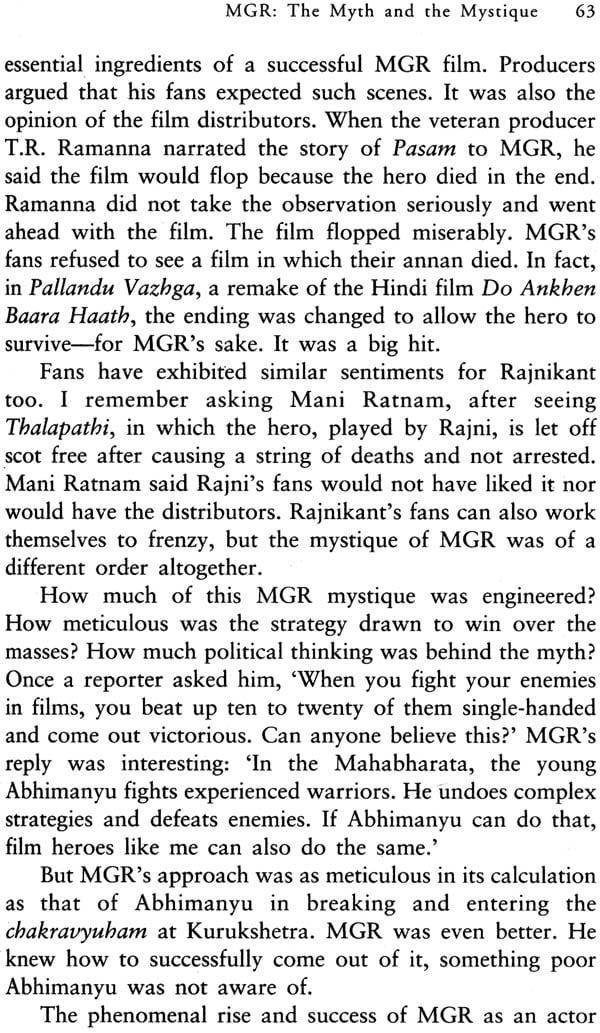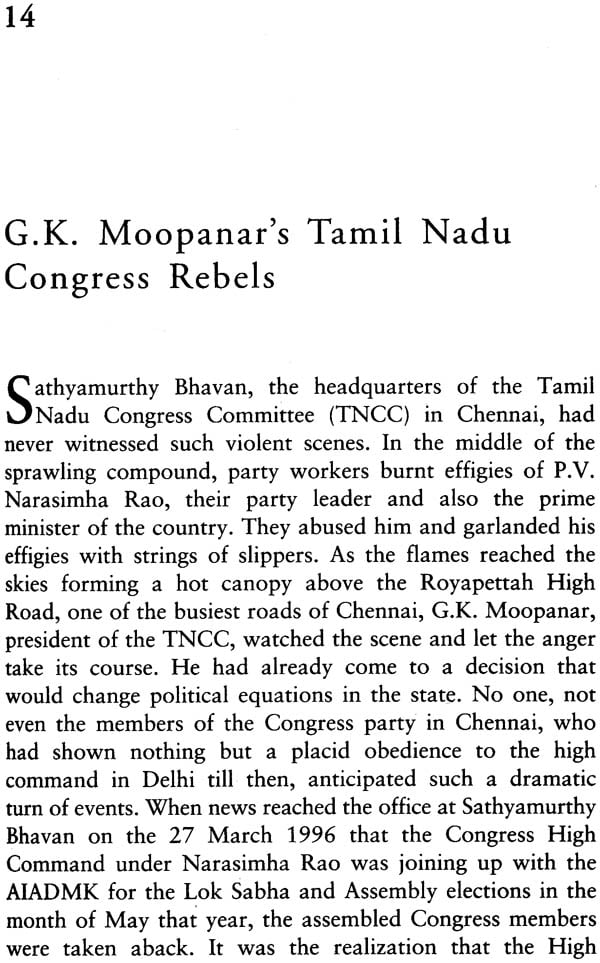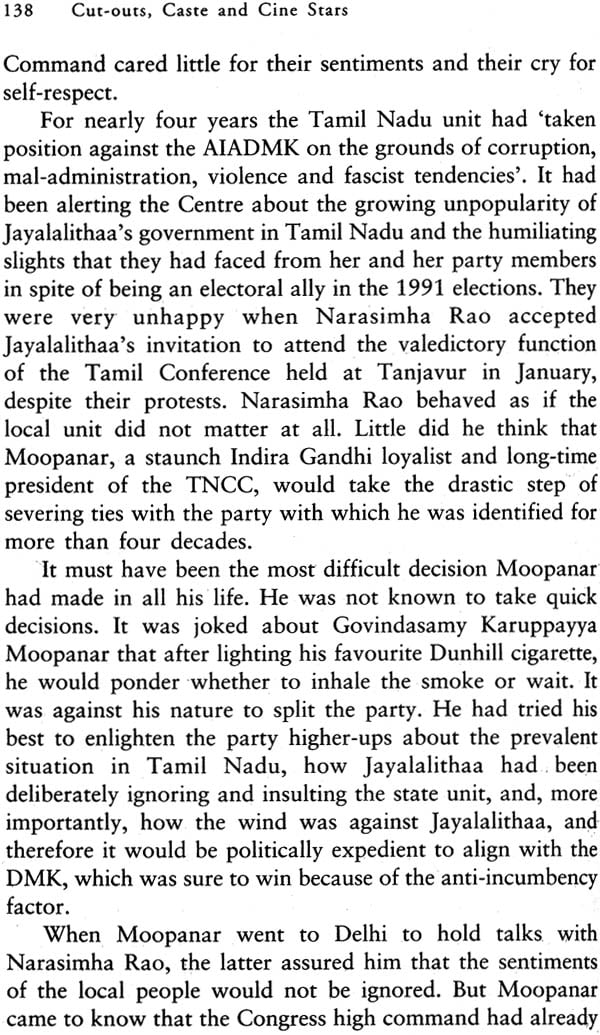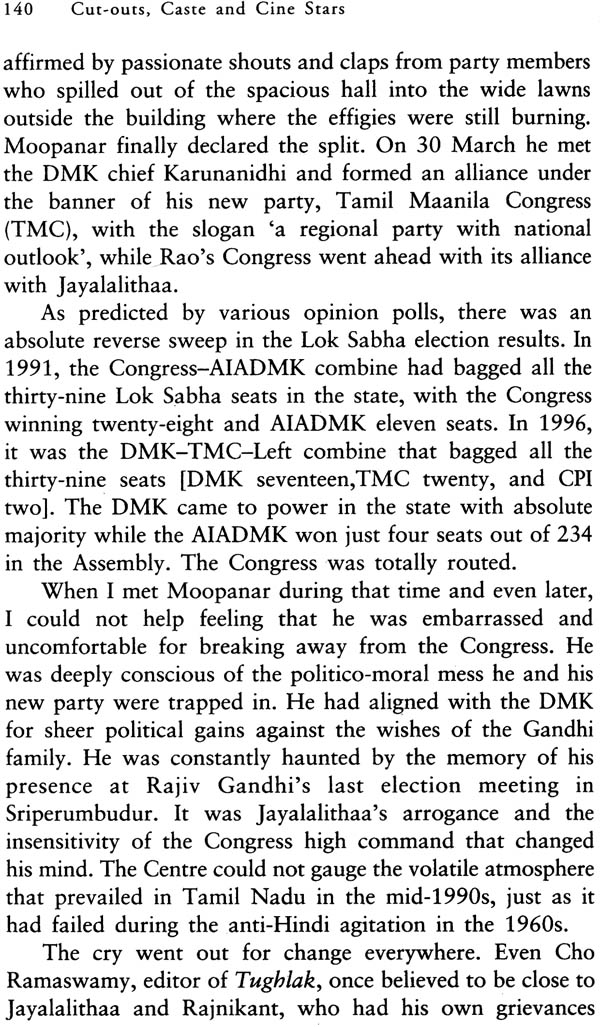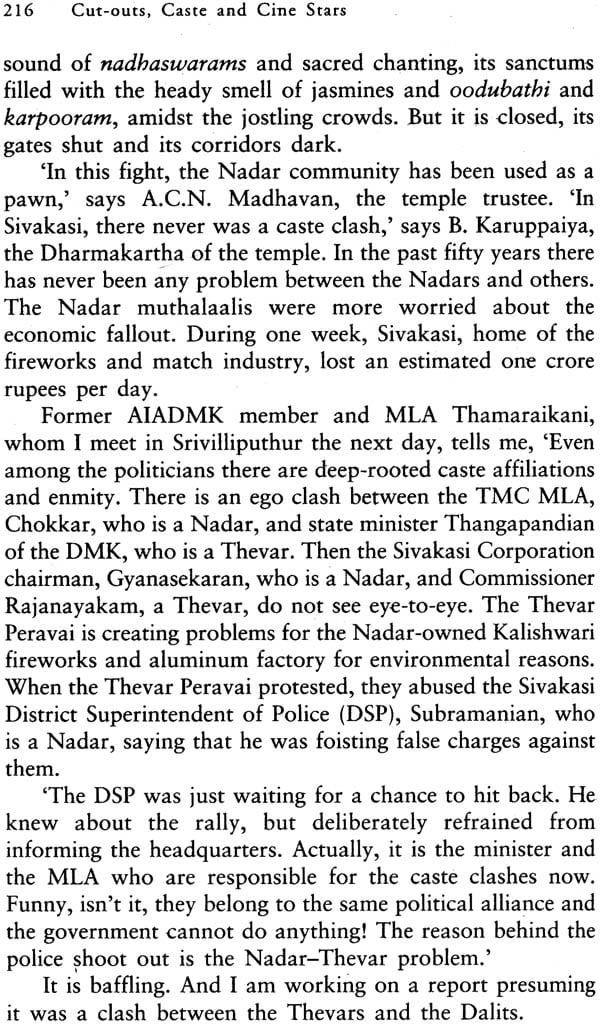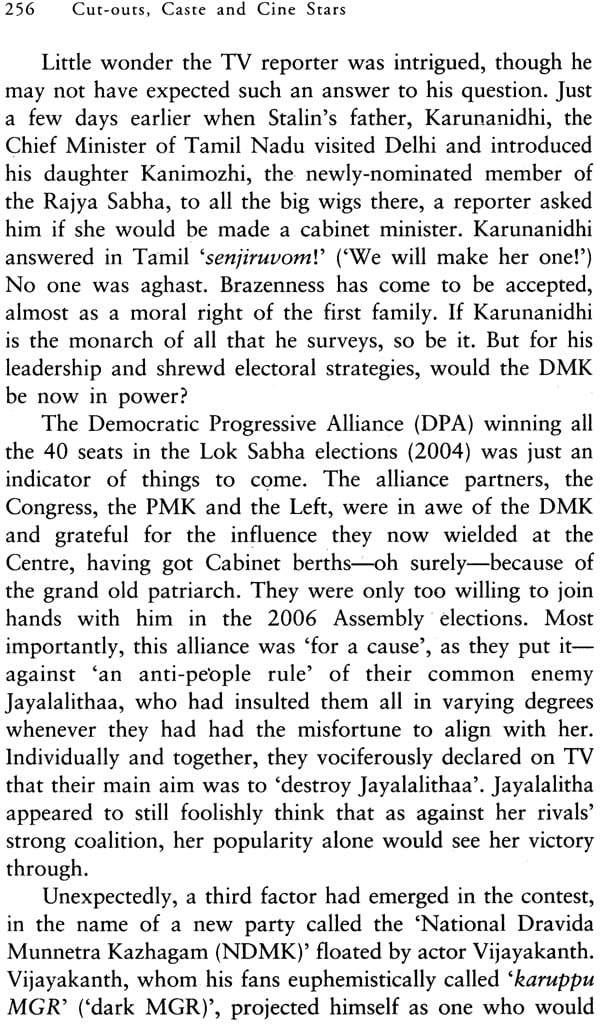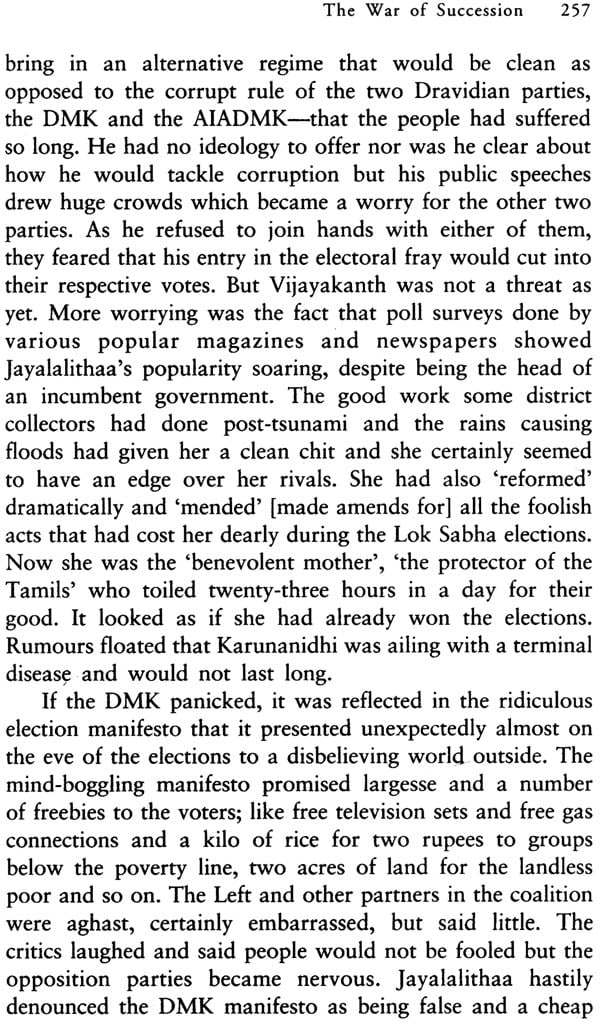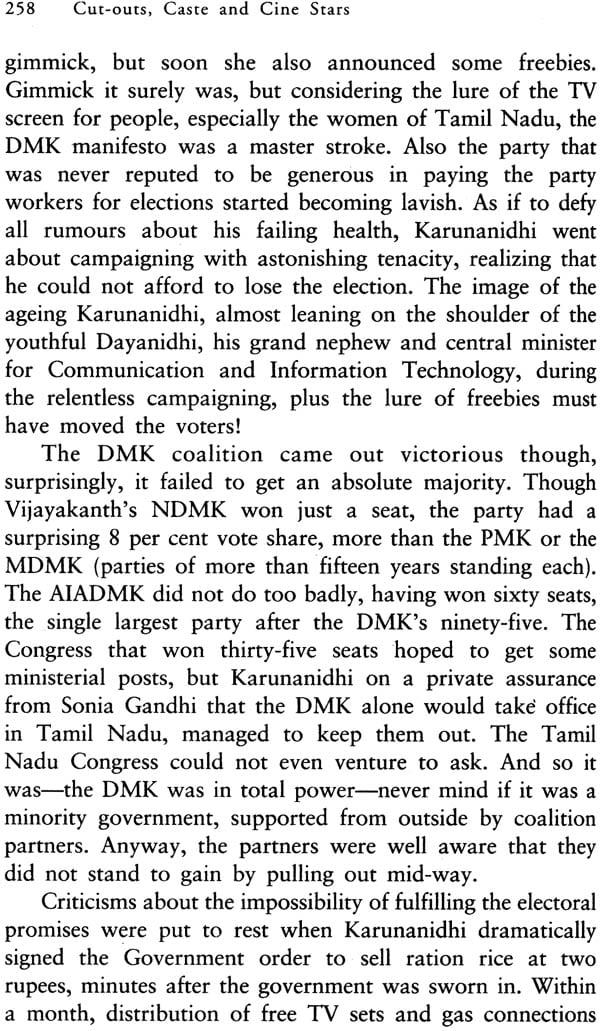
Cut-Outs, Caste and Cine Stars
Book Specification
| Item Code: | IDK847 |
| Author: | Vaasanthi |
| Publisher: | Penguin Books India Pvt. Ltd. |
| Language: | English |
| Edition: | 2008 |
| ISBN: | 9780143063124 |
| Pages: | 299 |
| Cover: | Paperback |
| Other Details | 8.6" X 5.6" |
| Weight | 300 gm |
Book Description
I got to write this book quite by accident. It would not have occurred to me write in English, in the first place. I have been writing in Tamil for quite some time, and worked as the editor of the Tamil edition of India Today magazine for nine of the most exciting years of my writing career. It was David Davidar who flung down the gauntlet most unexpectedly when I met him two years ago at his office in New Delhi. As I was casually narrating to him my journalistic experiences in Tamil Nadu, he suddenly asked me, 'Why don't you write about the oddities of Tamil Nadu politics for Penguin?' I was not prepared for such a proposal and therefore did not know what to say. 'There has been no such book written as yet,' he insisted. 'I cannot write an academic book,' I said, horrified at the thought of a voluminous book with footnotes. 'We do not want academic stuff,' he said, 'Write from your experiences as a journalist.'
So in a moment of weakness I agreed to write. Though the subject has always fascinated me, it was challenging. I was a Tamil writer and journalist who had always lived outside Tamil Nadu until I went to Chennai for the India Today assignment. I had grown up entirely in Bangalore at my grandparents house, and visited Tamil Nadu frequently to attend weddings of my numerous cousins, who mostly lived in Chennai, and every summer also to visit my parents who lived further south, in a small town, kovilpatti, near Ettayapuram, the birth place of poet Subramanya Bharati.
I have long nursed a great fascination for Tamil Nadu the splash of colour and vibrancy that saw in the attire of Tamil women, the glitter of jewellery, the heady smell of jasmine adorning the hair, was all very different from what one saw in the sober pasted-hued atmosphere of Bangalore. Even more fascinating was to listen to the men discuss politics; their passion was to strikingly charming. I had heard my grandfather, a staunch Congressman, speak disapprovingly of the crude tactics of E.V. Ramaswamy Naicker, the father of the Dravidar Kazhagam (DK), but approvingly of his anti-Brahmin agitation as historically justified. Anti-Congress sentiments, even among my cousins in Chennai, were quite obvious. They had a secret admiration for the Dravidianists who spoke Tamil with a flourish, and for Periyar, the heretic. There was something alluring in the Tamil that was spoken in the market and on the platform; one full of warmth, and the other theatrical [because most of the speakers were trained in the theatre] and pompous, yet attractive beyond description.
Every trip to Tamil Nadu made me feel I had a natural bond with the soil. Years later I had the opportunity to do some project studies on women's issues and I chose Tamil Nadu for my fieldwork. I did two studies, one on the state of women beedi workers in North Arcot district, and another on female infanticide in Usilampatti in Madurai district, which brought me closer to the rural women of Tamil Nadu. The journeys through the rural South during those years gave me an opportunity to observe the political climate of the state where the Congress party had been marginalized and Dravidian rule led by the Dravida Munnetra Kazhanam the DMK had taken over. The atmosphere seemed charged, and indicated a new wave of confidence.
As a journalist, I regret not having witnessed a momentous period in the history of Tamil Nadu. I had never heard Periyar's speeches nor witnessed the anti-Hindu agitation and the incredible passions it aroused in Tamil Nadu, a passion that made people sacrifice their lives at the alter of Mother Tamil, Tamil Tai. Tamil Nadu had challenged the imposition of Hindi, which would have reduced the Dravidian people to an inferior position at the national level. Tamil Nadu had gained notoriety by demanding secession. So notorious that the rest of the country did not realize for a long time that the demand was given up even before the DMK came to power in 1967 dethroning the Congress. The outside world condemned Tamil chauvinism, dubbing it medieval in spirit and anti-national party at the state. Non-Tamils may not have known that Periyar, who was hailed as Thamizhina thalaiver leader of the Tamil community spoke Kannada, his mother tongue, at home and had once described Tamil as 'a barbaric language'. Outsiders wondered why Tamils had an actor, MGR [M.G. Ramachandran, who was a Malayalee born in Sri Lanka], as the chief minister of the state for two terms and more.
The 'MGR phenomenon' baffled the nation. Tamil Nadu was distinctly shifting from its fiery Dravidian ideology of self-respect to a poster cult. All politicians sported dark glasses, making it a symbol of Tamil Nadu politics. Everything was larger than life and on visiting Chennai one could see little difference between the big screen and the scene on the street. MGR, the matinee idol, had become a living god. A temple had been built with an enshrined image of MGR in his trademark fur cap, dark glasses and gold watch. To the outsider it sounded crazy and ridiculous. The Tamil intelligentsia, a minority anyway, hung its head in shame. The poor worshipped him as their saviour for inexplicable reasons. There was one, however, for which even his detractors inside and outside Tamil Nadu praised him the noon meal system that he initiated for primary school children throughout the state.
I had met Jayalalithaa, the former actress and now the chief minister of Tamil Nadu, when she came to Delhi as a member of the Rajya Sabha representing the AIADMK (All India Anna Dravida Munnetra Kazhagam) founded by MGR. I had remarked during the course of my interview that the idolization of MGR in Tamil Nadu had reached ludicrous heights. 'What do you know about the people of Tamil Nadu sitting in Delhi, Come to Tamil Nadu and see for yourself why MGR is worshipped by people as a god.'
MGR was no more when the opportunity came for me to go to Tamil Nadu. But I saw the magic his name still invoked. Jayalalithaa was now in power, on the strength of the claim that she was his chosen successor. Tamil Nadu now looked very different from the other states where I have lived. Jayalalithaa was right. Being an occasional visitor was different from being an insider. I had to learn a good deal more to understand the ethos of the place and the mind of the people. Thanks to my distance from Tamil Nadu, many of the concepts of Dravidianism available to me remained only at the conceptual level and not, as would have been possible, at a more intimate or intuitive level, had I lived in Tamil Nadu. But distance also lent my encounters with politics in Tamil Nadu, which would not have been possible, were I an insider.
What is it that makes Tamil Nadu politics so different? Culturally and historically, Tamil Nadu has always been very different from the rest of the country. It spoke a language that was different from the languages spoken in other parts, including the South, which had roots in Sanskrit, the language referred to by the Dravidianists as vadamozhi, language of the North. If Sanskrit was the Deva bhasha, language of the gods, Tamil was the Muse herself, the Tamils claimed, it had a distinct grammar, as sophisticated as that of Sanskrit, but distinct in syntax and vocabulary, and with a literary tradition more than 3000 years old. Tamil Nadu's temples and temple architecture with colossal gopurams and inner sanctums were considered architectural marvels and it developed its own music and dance forms that civic amenities the Tamils had mastered the art of governance, of which we have documented proof dating back to the Chola period ten centuries ago.
Most importantly, the caste structure in Tamil Nadu was also different from that in the North. The Vedic theory of four main varnas, or castes, did not strictly apply in Tamil Nadu. Before the onset of British rule, there was considerable fluidity in social status in Tamil Nadu. But legalization of the caste communities that were locally ranked just beneath the Brahmins as low-caste Sudras, along with caste communities whom they felt superior to, prevented such a fluidity and created considerable social tensions, and resulted in the emergence of the Dravidian movement. The Tamil society witnessed during the British rule the extraordinary dominance of English-educated Brahmins in politics and civil society. Their dominance was a social irritant because of their 'religiously sanctioned superiority' and their notions of purity and pollution that encouraged them to be arrogant and treat the others with contempt.
I must mention two related developments of the late nineteenth century. One was an emerging classicism in terms of re-evaluation of ancient Tamil literary and religious tradition. The other was the effort to modernize Tamil and established its contemporary relevance. Discoveries in language were linked to a theory of a 'subdued Dravidian civilization' conquered by the invading Aryans from the north. Tamil Brahmins, whose dialect was marked by Sanskrit, were seen as Aryan descendants and also, in many quarters, as a different race. The indignation over Brahmin 'dominance' was thus combined with ideas of a racial and cultural distinction between the Brahmins and other communities. That, in turn, spread the 'language of rights by the turn of the twentieth century, which enabled and encouraged non-Brahmins to question the caste system. Logically, all these reasons were enough for the Dravidianists to clamour for secession around the time of Independence. It is, therefore, not surprising that people of Tamil Nadu and their politics should respond differently to changes both at the national as well as the local levels.
The most striking difference has been the regionalization of party politics in Tamil Nadu when compared with other states. While ethic forces were gaining ground in other parts of India as well, it was in Tamil Nadu that they dominated party politics. It is this that has, till today, prevented the growth of parties with an all-India face in the state. By transforming the Tamil language into an object of passionate attachment, by introducing notions of self-respect and regional pride and by providing their version of Tamil cultural history, the DMK spokespersons came out as better Tamil nationalists than the Congress, for instance. The party created what has been described as a 'hegemonic hold over Tamil political life and culture'. The Congress has long since been marginalized in the state for this reason.
The Tamils cannot relate to the BJP's Hindutva either, for the same reason. The increasing religiosity in evidence now in Tamil Nadu should not be attributed to the spread of the BJP. The BJP with its North Indian, Hindi-speaking, Hindu-fundamentalist veneer has made little dent on the Tamil psyche. The pronounced religiosity that is strikingly visible in Tamil Nadu is another contradiction that might baffle an outsider who has heard about the Dravidian movement and its atheist protagonist, Periyar. Ironically, the growing religiosity is the direct result of the shift in the caste hierarchies thanks to the Self-Respect Movement and the reservation benefits and the resultant upward social mobility, which has brought about a silent and willing 'Brahminization' of the backward communities who tend to project their caste status through their religiosity.
Tamil Nadu is a state very different from the rest of India, both culturally and historically. It has retained a fundamentally separate identity for itself in language and caste structure, and this is most evident in its politics.
Cut-outs, Caste and Cine Stars: The Word of Tamil Politics tells a political story that has all the elements of a blockbuster film, where ironies and larger-than-life characters abound: Periyar, a Kannada-speaker, who introduced the notions of Tamil self-respect and regional pride, yet dismissed Tamil as 'a barbaric language': the matinee idol MGR, a Malayalee born in Sri Lanka, who became Tamil Nadu's most popular mass leader; the Dravidian movement which, by its own ideology, should have helped the Dalits but has instead supported only the upwardly mobile middle groups; and parties that rose to power by propagating anti-Hindi and anti-Brahmin sentiments but have now allied themselves with the BJP. It is fitting that this reel-like scenario is presently dominated by the electoral politics of Karunanidhi and Jayalalithaa, one a scriptwriter and the other a former actress.
| Acknowledgements | vii | |
| A Timeline of Tamil Politics form Periyar to the Present | ix | |
| Introduction | xv | |
| 1. | Prophet of the new age | 1 |
| 2. | The Anti-Hindi Agitation | 24 |
| 3. | The Medium is the Message | 35 |
| 4. | The Coming of Age and the Dramatic Ascent | 42 |
| 5. | Karunanidhi's Ascendance and the Big Split | 50 |
| 6. | MGR: The Myth and the Mystique | 60 |
| 7. | Death and Resurrection | 76 |
| 8. | The Fury of Panchali | 84 |
| 9. | Kannari and Tamil Honour | 91 |
| 10. | Personality Cult | 102 |
| 11. | Birthday Bash | 107 |
| 12. | The Tiger Man | 116 |
| 13. | Eight World Tamil Conference | 127 |
| 14. | G.K. Moopanar's Tamil Nadu Congress Rebels | 137 |
| 15. | Intolerance of Dissent | 149 |
| 16. | Mother of all Weddings | 158 |
| 17. | The Iron Butterfly Behind Iron Bars | 164 |
| 18. | The Damning of Karunanidhi | 172 |
| 19. | Ideology Takes a Back Seat | 179 |
| 20. | Caste Politics in Periyar's Tamil Country | 189 |
| 21. | Puthiya Thamizhagam Krishnaswamy | 197 |
| 22. | All in the Name of Caste | 213 |
| 23. | Election Melodrama | 220 |
| 24. | The Predawn Knock | 232 |
| 25. | Karunanidhi: Forever the Scriptwriter Kalaignar | 243 |
| 26. | The War of Succession | 255 |
| Bibliography | 273 | |
| Index | 276 |



